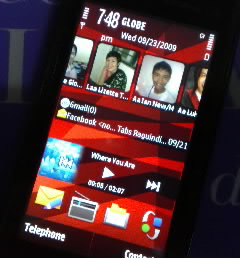I am sharing below an article written by my colleague Kelley Coblentz Bautch on videoconferencing.
How Videoconferencing with International Scholars Can Enliven Your Classroom
By Kelley N. Coblentz BautchSt. Edward’s University, Austin, Texas
“So,” asked the students of Prof. Revelation Velunta, “Why do you want to speak with us? Whydo you want to know about the study of the Bible in the Philippines?” The students wereaddressing us from Manila, where it was midnight their time. By means of videoconferencing—namely using Skype [Sky-Peer-to-Peer technology]), students from St. Edward’s University inAustin, Texas who were taking an introductory class had just had an opportunity to learn about“Decolonizing the Bible” from Revelation Velunta, Professor of New Testament and CulturalStudies at Union Theological Seminary (Philippines) in real time.
Prof. Velunta spoke with thestudents about the Philippines and its colonial past and how the experience of colonialism affectsone’s experience of reading the Bible. My students who had become accustomed to taking intoconsideration the historical context of ancient texts were thinking further about the context ofthe reader of these texts. Professor Velunta helped my students think about how biblical texts areread in different communities and to realize more clearly their own social location. Needless tosay, the experience was an important one for my students and for me.Why should a biblical scholar and her students in the United States speak with a scholar in thePhilippines? Why should an educator communicate with scholars in other countries about one’sdiscipline? Why share such interchanges with students? I can offer many good reasons. Myuniversity, although located in an urban and culturally diverse region, is interested in deepeningthe global awareness of our students. While we encourage study abroad and host a number ofnotable programs for students (such as in Angers, France and Edinburgh, Scotland), faculty arealso thinking about how we can further internationalize our students’ education even on campus.Further, I have been working to make the classroom interactive and dynamic and have soughtways to share with students and to make concrete the various methodologies and approaches toreading the Bible and the nature of scholarly exchange. By speaking with a biblical scholar fromthe Philippines, my students have the opportunity to learn new perspectives and to experience thediversity and dynamism of the academy. These lofty goals I have been able to realize, in part, by1 I would like to thank Revelation Velunta and the students of Union Theological Seminary (Dasmarinas, Cavite,Philippines), Milton Acosta, and Christo Lombaard for their generosity in sharing their time and expertise withstudents at St. Edward’s University. I would also like to express my appreciation for Eric Trimble, Faculty ResourceCenter Manager of St. Edward’s University, who facilitated these video-conference sessions, and for LeighAndersen, Managing Editor of Publications, Society of Biblical Literature, for reading a draft of this essay andoffering helpful suggestions.inviting Prof. Velunta to speak with my students. The most important rewards are at theinterpersonal level. My horizons and those of my students have been expanded. Prof. Veluntachallenged us to read biblical literature differently and while we realized through the exchangeour differences, we also were reminded of how these differences enrich our world. Further,through humor as well as frank discussion of difficult texts and through Prof. Velunta’sencouraging us to reflect on our own gifts, we were reminded of our common humanity andabout what we share.Our visit with Professor Velunta of about one hour was transformative for us, recalling in manyrespects the experience of travel abroad. I have always been convinced that internationalexperiences are essential to our development. From study of languages to cultures, biblicalscholars are well poised to grasp the importance of awareness of other contexts and peoples. Ihave been enriched and challenged through such experiences and have certainly grown as aresult. The opportunities to learn from and study with excellent scholars outside of one’s homecountry, to conduct research abroad and to participate in symposia and conferences (such as theSociety of Biblical Literature International Meeting) that bring together scholars from around theworld are truly gifts that assist us in our intellectual development and scholarship. The Society ofBiblical Literature also recognizes the value in international exchanges.“The SBL launched the International Cooperation Initiative (ICI) to foster biblicalscholarship and to facilitate mutual cooperation among colleagues.” (Description of “theInternational Cooperation Initiative” (ICI), http://www.sblsite.org/InternationalCoopInitiative.aspx).“In accordance with the recommendations of the International Cooperation Initiative(ICI), SBL is establishing a set of lists that will facilitate faculty cooperation, includingexchange and co-supervision among scholars and institutions in different parts of theworld.” (the “ICI Teaching Collaboration Program”; http://www.sblsite.org/educational/ICITeaching.aspx).The International Cooperation Initiative (hereafter, ICI) and its various projects that facilitatebiblical scholarship and teaching globally are, for me, welcome additions to the Society ofBiblical Literature. In addition to being able to pledge financial support for the ICI Program, Iwas delighted to have the opportunity to demonstrate my interest in academic exchange by beinglisted on the ICI Scholar List. The “Scholar List” assists international cooperation by providing adatabase of biblical scholars who are interested in supervising or mentoring students from othercountries, teaching abroad or hosting faculty from abroad, or teaching via electronic media.While I look forward to participating further in the various kinds of scholarly exchangefacilitated by the ICI program, I can share how the Scholar List has been helpful to my studentsand me thus far.I consulted the list this last year as I sought out colleagues to serve as guest speakers by means ofvideoconferencing for some of my classes. Three biblical scholars from outside of NorthAmerica who are participants in the ICI program and willing to teach via electronic media wereespecially important in providing my students with an international perspective and, I think,expanding my students’ horizons vis-à-vis the Bible. Thanks to the ICI program andvideoconferencing, my students were able to meet and learn from Milton Acosta, Professor ofBible and Theology at the Fundación Universitaria Seminario Biblico in Medellin, Colombia,Christo Lombaard, Professor of Christian Spirituality of the University of South Africa inPretoria, and Prof. Velunta whose presentation I described above. Students at St. Edward’sUniversity benefited from the presentations of Profs. Acosta, Lombaard, and Velunta, as eachcommands different areas of expertise within biblical studies. At the same time, these biblicalscholars are masterful teachers who also brought new vistas to my students and their encounterwith the Bible.How so? A number of my students remarked that Skype was especially valuable in providingthem with a global perspective on the study of the Bible. For example, I asked students what theyknow about the Bible as a result of our visits with scholars from other countries that they wouldnot know otherwise; one student responded: “(the guest lectures) helped me to grasp the fact thatthe Hebrew Bible is interpreted differently throughout the world and (that) living conditions andpast experiences play a huge role in the interpretation of the Bible.” When asked about hisexperience speaking with our class, Prof. Velunta shared: “Opportunities to meet and interactwith people from different and diverse contexts and cultures make education exciting andchallenging.” My students and I wholeheartedly agree.While the use of technology in the classroom may not always be without difficulties and whilebringing scholars to my campus or having students and me travel to theirs would be especiallydesirous, with limited resources in the way of time and money, videoconferencing offers anotheralternative for international cooperation and scholarly exchange in the classroom. As Prof.Lombaard describes:
The chance to share one’s insights with students who are oceans and continents away issomething very special. Usually this dynamic is limited to one’s own students, and a fewcolleagues at conferences. In the past, it was only with substantial commitments in traveland time that lecturers had the privilege of sharing their newly developing ideas withstudents in other contexts. Now, via technology, and facilitated by the SBL’s ICIprogram, this has become much easier. Although there is no match for the full dynamicof being present in person in a class, technologically mediated classes are by no means analternative to be ignored.
I will always encourage my students to travel and study abroad; likewise, I will seek to visitpeers in their countries and find ways to facilitate their travel and mine so that we can worktogether and continue to learn from one another. Additionally, I am grateful that technologywould allow us to share with our guild, communities, and students the knowledge and wisdom ofcolleagues in distant lands. When funding or the means of travel is not available,videoconferencing—particularly Skype, which is available for free—can still provide studentswith a virtual window of the world. Prof. Velunta similarly notes:
Technology allows people to cross borders that most would not be able to cross. (Videoconferencing)provides us the next best thing to face-to-face encounters. Moreover, Iremember Sean Connery sharing that, being very, very poor, he got the greatest gift he’sever received when he was five years old. He learned to read. For many today, especiallyin my part of the world, Skyping provides a similar gift.
Thus, if you are interested in teaching with electronic media, participating in scholarly exchange,and would like to further interact with colleagues from around the world, be sure to visit the“Scholar List” and learn more about SBL’s International Cooperation Initiative.
Prof. Lombaard shared with me: “My experience teaching Professor Coblentz-Bautch’s class atSt. Edward’s University was as positive for me as it seems to have been for her students. Had itnot been for the ICI program, this would never have happened.” Thank you, Society of BiblicalLiterature, and members of the ICI Executive Board; you are indeed facilitating mutualcooperation among colleagues and are internationalizing our professional society in manypositive ways.





 The tasks I do require me to have at least two phones on my person most of the time. I do have a preference for smartphones. To this day, I think the Psion 5mx and Revo Plus remain unequaled.
The tasks I do require me to have at least two phones on my person most of the time. I do have a preference for smartphones. To this day, I think the Psion 5mx and Revo Plus remain unequaled.


